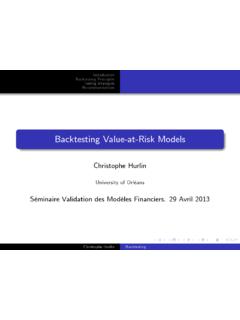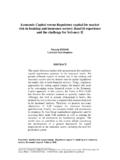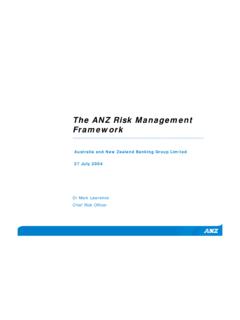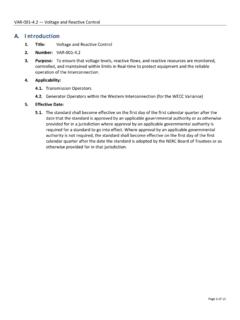Transcription of Non-parametric VaR techniques. Myths and Realities.
1 Non-parametric VaR techniques. Myths and Realities. By Giovanni Barone-Adesi(1) and Kostas Giannopoulos(2) November 2000 (1) Universita della Svizzera Italiana and City Business School, email : (2) Westminster Business School, email: G Barone-Adesi & K Giannopoulos 1 VaR ( value at Risk) estimates are currently based on two main techniques, the variance-covariance approach or simulation. Statistical and computational problems affect the reliability of these techniques. We illustrate a new technique , filtered historical simulation, that is designed to remedy some of the shortcomings of the simulation approach. We compare the estimates it produces with traditional bootstrapping estimates.
2 1 Introduction Early VaR ( value -at-Risk) techniques were linear multipliers of variance-covariance estimates of the risk factors. This class of market risk techniques soon became very popular, mainly because of their link to Modern Portfolio Theory. However, during worldwide market crises users noticed that early models failed to provide good VaR estimates. In addition, variance-covariance VaR techniques require a large number of data inputs; all possible pairwise covariances of the risk factors must be included in a portfolio. To process all the necessary information demands much computer power and time. Factorisation methods provide only partially satisfactory answers. The early VaR models are also referred as parametric because of the strong theoretical assumptions they impose on the underlying properties of the data1.
3 One such assumption is that the density function of risk factors influencing asset returns must conform to the multivariate normal distribution2. The empirical evidence however, indicates that speculative asset price changes, especially the daily ones, are rather non-normal. Excess kurtosis will cause losses greater than VaR to occur more frequently and be more 1 parametric VaR models are based on strong theoretical assumptions and rules. They impose that the distribution of the data (daily price changes) conforms to a known theoretical distribution. The most popular of these models is the exponential smoothing (ES), see RiskMetrics . 2 The normality assumption is frequently used because the normal distribution is well described; it can be defined using only the first two moments and it can be understood easily.
4 Other distributions can be used, but at a higher computational cost. G Barone-Adesi & K Giannopoulos 2extreme than those predicted by the Gaussian distribution. Many risk managers remember the large losses they faced during the Mexico (1996), Asian (1997) and Russian (1998) market crises. During these periods negative returns several standard deviations beyond the threshold predicted by the normal distribution3 were recorded within only few days. A large number of markets were crashing together; the correlation forecasts used to calculate VaR failed to predict such a synchronous crash. That resulted in further VaR failure. The problems of earlier models spurred the search for better estimates of VaR. A number of recent VaR techniques are based on Non-parametric or mixture of parametric and Non-parametric statistical methods.
5 The family of Historical Simulation (HS) models belongs to the former group. The Filtered Historical Simulation (FHS) as developed by Barone-Adesi et al (1998) and Barone-Adesi et al (1999, 2000) belongs to the second group. In this paper we analyse the assumptions upon which these models are based. In addition we compare the VaR estimates produced by the above models in linear and non-linear portfolios. 2 Literature review Regulators require that financial institutions backtest their internal VaR models, see Basle Committee on Banking Supervision (1995). Although the popularity and the use of HS has increased during the last few years, reports of backtests conducted by users are not publicly available. Some researchers however used smaller portfolios to backtest HS.
6 Van den Goorbergh and Vlaar (1999) used rolling windows of different lengths (250, 500, 1000 and 3038 days) over a fifteen year period to backtest HS daily data on the AEX (Dutch equity index). They found that the failure rate, the probability that actual losses exceed VaR, is often exceeding the corresponding left tail probabilities. Van den 3 At 99% probability. G Barone-Adesi & K Giannopoulos 3 Goorbergh and Vlaar found that results are sensitive to the selection of the window length4. In another study Vlaar (2000) investigates the accuracy of various VaR models on Dutch interest rate based portfolios. He concluded that HS produced satisfactory results only when a long history is included in the data sample.
7 Brooks and Persand (2000) investigated the sensitivity of VaR models due to changes in the sample size and weighting methods. They used a set of equally weighted portfolios each containing two asset classes selected from a set of national equity indices, bond futures and FX rates5. They found strong evidence that VaR models could produce very inaccurate estimates when the right historical data sample length is not selected. Perhaps the most comprehensive model comparison study published to date has been carried out by Hendricks (1996). Hendricks used 4,255 daily observations of eight FX rates against the US dollar and several performance criteria to study the performance of twelve VaR models. The twelve VaR models were grouped in three categories, equally weighted moving average, exponentially weighted moving average and historical simulation approaches.
8 He found that none of the twelve approaches is superior to others in every criterion. Furthermore, Hendricks reported that risk measures from the various VaR approaches for the same portfolio on the same date could differ substantially. Differences in the accuracy across models were also sensitive to the choice of the level of probability used in the VaR calculation. When a 95% probability was used in the VaR calculation, Hendricks found that the three approaches produce accurate risk measures. However, when a 99% probability was used there was a large discrepancy in the risk calculation between the three approaches. In general the three approaches predict only between percent and percent of the outcomes. Hendricks failed to single out 4 They strongly criticised the use of HS in predicting extreme events (far left on the tail) when the window is not of a substantial length.
9 5 The indices used were S&P500 and FTSE100. The bond portfolios were the 30-year US Treasury bonds; UK Gilt and long term German Bund. The FX rates used were dollar/Swiss franc, dollar/Dmark and dollar/Yen. The US Treasury bond rates were obtained from near-month futures prices on the 30-year interest rate. No information was given for the other two bonds. G Barone-Adesi & K Giannopoulos 4any VaR approach and he predicted that a more accurate a VaR model may be born by combining the best features of each single approach. Pritsker (2000) reviews the assumptions and limitations of Historical and Weighted Historical simulation (Boudoukh et al 1998). He points out that both methods associate risk with only the lower tail of the distribution. In an example he showed that after the crash of 1987 the estimated VaR of a short equity portfolio, as computed by Historical Simulation or Weighted Historical Simulation, did not increase.
10 The reason is that the portfolio recorded a huge profit during the day of the crash. Pritsker goes further by formulating some interesting properties of the Historical and Weighted Historical simulation. He showed that if the portfolio's return follow a GARCH(1,1) process, then at a 1-day VaR horizon and 99% confidence level, the historical simulation and weighted historical simulation method fail to detect increases in VaR about 31% of the time. In a simulated example he showed that the VaR on a short equity portfolio did not increase the days after the crash of 1987. Barone-Adesi et al (1999) carry out an extensive backtest analysis for the FHS model. They used economic and statistical criteria to analyse the breaks on 100,000 daily portfolios held by financial institutions.







